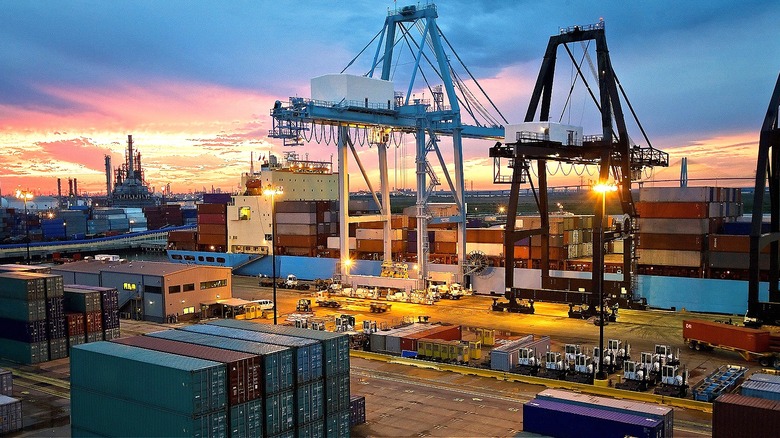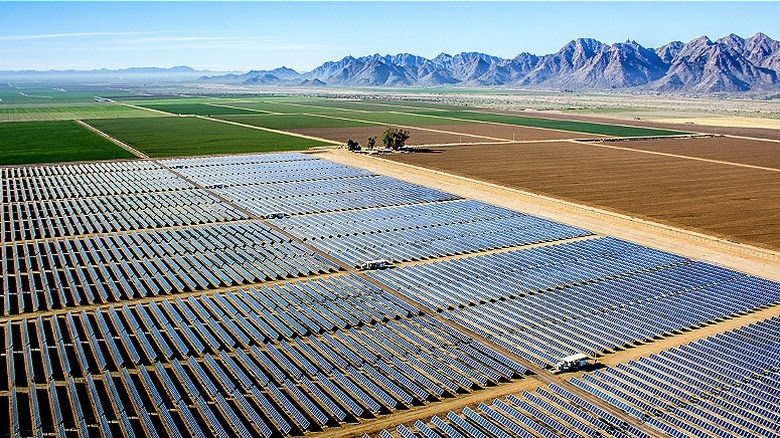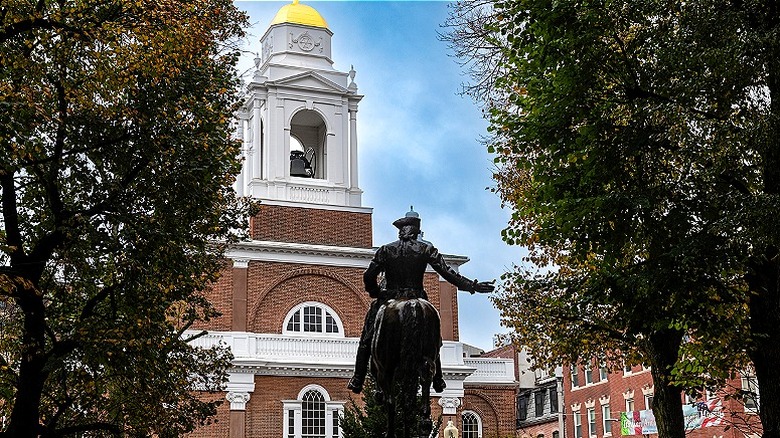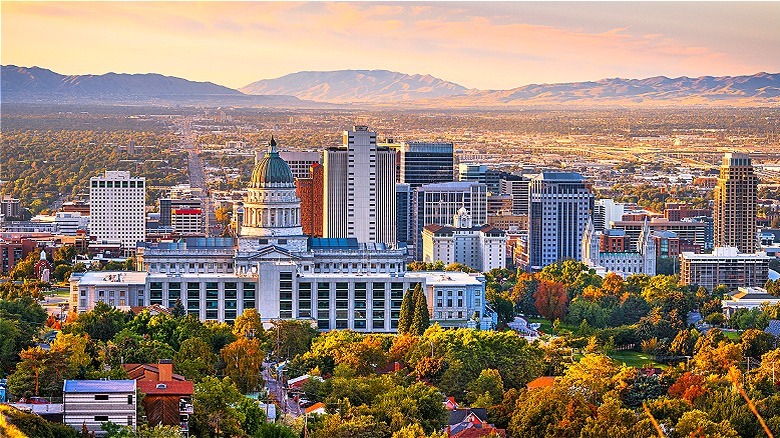States With The Best Economies In 2024
In this current economic climate of uncertainty and the roller coaster of inflation, any chance to secure a financial leg up is a good idea. That might mean anything from changing your savings strategy to packing your belongings and making a move across state lines. The good news, according to Statista, is that inflation appears to be slowly on the decline, dropping to 2.9% in July 2024, a difference of .3% from July 2023's 3.2% rate. Better still, Statista projects the inflation rate will drop to 2% by 2025 before rising to 2.1% where the data suggests it may remain static until 2029.
However, since inflation impacts the power of your dollar and the country is still riding out a period of instability, researching states where you can earn the highest average salary or with better economic opportunities is increasingly important. MoneyDigest has done the work of compiling a list of states with the best economies in 2024 so you don't have to, considering everything from employment opportunities to state and venture capital investment in local industry, along with access to health care and education.
Arizona
Aside from being able to boast of being one of the best budget travel destinations in the U.S. and home to one of the seven natural wonders of the world, the Grand Canyon, Arizona can also lay claim to having a thriving economy. According to the Arizona Commerce Authority, both the state and leading companies in the sector have poured a hefty amount of capital into the semiconductor industry here. The hope of profiting from a shift to EVs, for example, with battery cell and chip manufacturing has led to $102 billion in investment and the creation of 15,700 jobs. Intel had its $34.5 billion capital investment boosted by the Federal government's CHIPS Act fund, adding an additional $8.5 billion to the company's investment in Arizona and 3,000 jobs. TSMC's $65 billion investment was beefed up by $6.6 billion in CHIPS funding, leading to another 6,000 jobs. The state has invested in educating a workforce capable of taking advantage of the coming opportunities through a workforce accelerator program implemented in community colleges across Arizona, and an industry-led 10-day, 40-hour boot camp that's already trained over 900 students.
In 2023, LG Energy Solutions, a supplier to Tesla, upped an initial $1.4 billion investment in a battery plant to $5.5 billion with a plan to manufacture EV batteries by 2025 and energy storage systems by 2026. Information technology, aerospace and defense manufacturing, renewable energy, mining, agriculture, tourism and biomedical engineering are also driving Arizona's booming economy.
Delaware
Two-thirds of American Fortune 500 companies including major players like Google, Walmart, and Amazon, have chosen Delaware for its rich tax benefits, limited restrictions, and easy going corporate regulations. If you own a corporation in Delaware that does business elsewhere, you pay no corporate taxes, nor are there sales, investment income, personal property, or inheritance taxes. Even if a corporation does do business in the state, if they do so through shell or subsidiary companies, a loophole allows for an exemption from the in-state tax. In 2023, according to the United States Census Bureau, there were 55,103 business applications in the state, representing a median growth of 21% across New Castle County, Kent County, and Sussex County.
All this corporate interest driven by favorable conditions have helped bring in a recent $276 million in foreign investment and an uptick of 1.2% in employment for the state. While the median household income in the U.S. as of 2022 was $75,149, Delaware is above the national median at $79,325. Although Delaware's GDP shrunk by 1.2% in 2023, it still managed a GDP of $74.3 billion. According to the Bureau of Economic Analysis, the state rebounded in the first quarter of 2024 with the second largest jump in personal income — driven by real estate, leasing, and support from local and state government — with earnings climbing by 7.2%.
Nevada
As per Statista, Nevada's GDP grew from $187.23 billion in 2022 to $192.22 billion in 2023. That's from a low point at the height of COVID-19 when the GDP dipped from $175.77 billion in 2019 to $165.79 billion in 2020. That's a difference of $26.43 billion in a short four-year period, demonstrating the economic engine powering the state. The Pew Charitable Trusts reviewed tax revenue for states across the country and found that Nevada was one of the top five states for tax revenue collection in the last quarter of 2023, with a 15-year long-term trend showing the state 4.9% above others. This is impressive considering the national trend at the time was 3.2% or less for a majority of states. Nevada doesn't enforce any wide-spanning personal income taxes, preferring to make the majority — about 55% of state revenue — from sales taxes.
While Nevada may have you think of gambling, sites operated by the National Park Service in Nevada generated $385 million in tourist dollars in 2023. The Lake Mead National Recreation Area alone saw 5.8 million visitors who were the catalyst for 3,130 jobs and hundreds of millions of dollars in state revenue. In The New York Times, Gov. Joe Lombardo credits lowering business taxes, removing bureaucratic barriers, and corporate incentives for creating $5 billion in private-sector investment in his first year as governor. In 2024, Nevada is working with local business leaders to promote more economic growth in the state.
North Carolina
With a GDP of $625 billion and 1.4% growth in employment in 2023, North Carolina is a great state in which to invest in your future. According to the U.S. Bureau of Labor Statistics, North Carolina's unemployment rate of 3.7% as of July 2024 falls well below the national average of 4.2%. This has no doubt contributed to its rapid population growth as per the United States Census Bureau, where between July 2022 and July 2023 some 139,000 people migrated to the state, representing a rise of 1.3% out of just over 10.6 million people. North Carolina was one of four states — including Texas, Georgia, and Florida — that made up 67% of U.S. population growth in 2023.
Interestingly, both 2024 presidential candidates – Vice President Kamala Harris and former President Donald Trump — chose North Carolina as the place to unveil their economic strategies for the nation. The Economic Development Partnership of North Carolina Inc. (EDPNC) provides some clues as to the importance of the state to national business interests, with a low corporate tax rate of 2.5% which is projected to hit zero by 2030. Rated the top state for business in 2023 by CNBC, initiatives like the Job Development Investment Grant n(JDIG), the One North Carolina Fund (OneNC), and a few development grants offer more financial incentives to businesses who create employment opportunities in the state.
Tennessee
According to a joint study courtesy of trade organization E4 Carolinas and the Southeast Nuclear Advisory Council, nuclear power generation helps boost the economy of Southeastern states — Tennessee, Virginia, North Carolina, South Carolina, and Georgia — by as much as $42.9 billion in recent years. Once you throw in the added bonus of 152,598 high-paying jobs with wages 65.5% above the regional average, and a thriving nuclear power industry that contributes to job growth in other sectors — for every 10 nuclear jobs, 18 jobs are created in other industries — you have the the foundation for a stable and thriving local economy. With those kinds of numbers from a single industry, the $3.7 billion in tax revenues divided up between Tennessee and the other states is just icing on the cake. In Knoxville, Roane State Community College and the University of Tennessee are offering students educational grants to replace the aging population of nuclear workers in the state, 25% of whom are 55 years old and up.
According to a study by Tourism Economics, some 8 million people visited 25 Tennessean distilleries. A combination of on-site and off-site purchases amounted to $3.25 billion in 2022, with the addition of creating 30,000 part-time and full-time employment opportunities. This whiskey tourism helps prop up local hotels, restaurants, bars, convenience stores, local retail, public transportation, gas, and local entertainment venues. In addition, in 2022 6% of all U.S. built vehicles were built in Tennessee, which provides employment for 142,900 people.
Texas
They say everything is bigger in Texas, and where the economy is concerned "they" may be correct. As the second-fastest growing economy in the U.S. in 2023 — second only to California in the number of S&P 500 companies — Texas generates an impressive $2.03 trillion GDP, which easily dwarfs every other state on this list. As per the Texas Economic Development Corporation, Texas would be considered the eight largest economy in the world if it was its own country, with 15 million workers making it the second-largest workforce in the U.S. Major global corporations including Tesla, Amazon, and Big Oil magnates like ExxonMobil — Texas generates 40% of the nation's oil and one-fourth of its natural gas — contribute to a widening group of leading public and private companies helping to raise the states' profile. This doesn't even take into consideration the other 3 million small business operators in the region.
With $20.7 billion in foreign investment in 2022 and rising job numbers of 2.1% in 2023, it's no wonder the state has invested $50 million in job training for the demands of the local economy. There are currently 125 technical programs and 300 trade schools able to potentially benefit from this investment called the Texas Reskilling & Upskilling through Education (TRUE) program. The state has no corporate or personal income taxes. There's a tiny franchise tax of 0.375% to 0.75% for companies generating revenues over $1.23 million, making the state tax-friendly for business and the workforce.
Massachusetts
With a GDP of $734 billion bolstered by health care, tech, manufacturing, tourism, and education, Massachusetts is both a great place to live and work. The state was also the first to legalize gay marriage, and quickly adopted former president Barack Obama's Affordable Care Act to improve access to health coverage for its citizens. Massachusetts was awarded $15.7 billion in defense contracts in 2020 alone and was the leading state for defense contracts in the nation in 2021. This makes sense considering there are no less than 7 military bases in the state creating 57,000 jobs that add $13 billion to the economy. There are also 345 robotics labs in the state, including industry leaders iRobot and General Dynamics. Even education is a factor in the state's fortunes. Tufts University contributed $2.1 billion to Massachusetts economy between July 1, 2022 to June 30, 2023, with 11,673 jobs and $101.4 million in state and local taxes.
Manufacturing is huge in Massachusetts, employing over 250,000 people and schools in the state award over 9,000 engineering degrees per year. Computers and electronics were manufactured at double the national average in 2021, and the manufacturing sector has a $60 billion output. While Massachusetts is one of five states with the highest electricity bills in the U.S., it's also a major investor in clean, renewable energy. There are 114,000 people employed in the sector with a focus on marine technologies.
Idaho
Idaho is somewhere perfect for both working and retiring if you stick around long enough. In fact, it's one of the cheapest states in the U.S. to retire, with a growing small business economy represented by 4.5% more business applications in 2023. While Idaho's $94.9 billion GDP may be smaller than other states on our list, it grew at a rate 3.5% higher in 2023, which is higher than the other states listed. Even though there's not much in the way of foreign investment, job growth of 2.5% last year reflects plenty of opportunity. The Support Local Gems initiative, launched by the state in 2020, recognizes the importance of small businesses in Idaho by asking citizens to make a special effort to support local businesses on a specific day of the year.
Idaho prides itself in farming, with potato production being synonymous with the state. However, cattle and sheep ranching, grain, seed, beets and legume farming are also a big part of that industry. With a land mass comprising two-thirds forest, the lumber industry is also strong. As the third-highest producer of dairy products in the U.S., the industry generates 33,000 jobs. Manufacturing, transportation, and the service sector round out the rest if you're not the outdoorsy type.
Utah
In 2023, Utah generated a GDP of $219.2 million, representing 2.5% growth from the previous year, and a rise in employment numbers of 2%. Out of 10 major industries in the state, eight reported larger job numbers than in previous years. Although mining, forestry, agriculture, and fishing used to be drivers of the economy, they've since been replaced in importance by finance, manufacturing, service jobs, tourism, and Information Technology. According to the Bureau of Economic Analysis, personal income in Utah rose 7.5% in the first quarter of 2024.
The Utah Office of Tourism notes that 2023 saw $2.35 billion in revenue and 159,800 jobs created by tourists who spent $12.71 billion in the state. The Kem C. Gardner Policy Institute concluded that banking and finance in Utah is the fourth-largest industry behind real estate, manufacturing, and government services. With the ninth-highest concentration of financial services in the U.S., the sector represents 8.4% of Utah's GDP. This concentration of 56 banks, along with two thrift banks, managed $944 billion in deposits in 2023, and credit unions in the state held $54 billion in assets. More than half of the banks specializing in industrial loans operate in Utah, with 15 out 24 of them managing $207 billion in assets. In 2022, gig workers added $1.8 billion to the economy, and in 2024, gig workers became eligible for health benefits. In 2022, Utah broke set a record for revenue generated by outdoor recreation, generating a whopping $8.1 billion.
Georgia
Georgia's impressive GDP of 661.1 billion is bolstered by the presence of major international companies like Mercedes-Benz USA, Adidas, and Nestle Purina, which accounted for $9.7 billion — or 1.5% of the state's GDP — in 2022. Several industries take the lead in Georgia. FinTech is a preeminent presence in the state, with 70% of the nation's financial transactions being processed in Georgia. The state is called "Transaction Alley" since it provides a home for over 200 companies leading in data analysis, cybersecurity, online banking, and blockchain technology that contribute $72 billion in revenue annually.
With a $708 million investment granted by the National Institute of Health, health care technology has also been given a boost, and from 2019 to 2022 jobs in this sector grew by 20%. The state is also a big player where transportation infrastructure — airport, highways, railway network — supporting the supply chain is concerned. 85% of third-party companies managing logistic networks operate in Georgia. The state has also been dubbed "The Hollywood of the South" for its forays into over 400 film, video, and television projects that had an economic value of $5.54 billion in 2022.
Aerospace manufacturing is the primary industry of the state, with $11.1 billion worth of exports creating an economic impact of $57.5 billion for the aerospace economy in 2023. It doesn't hurt that 800 aerospace companies are located within the state. Due to tax-friendly policies with little government regulation, Atlanta is quickly earning the nickname "Silicon Valley of the South."
Montana
Montana has become another manufacturing behemoth. With 1,390 manufacturers providing work for 24,557 workers, the state's incredible amount of natural resources make it no surprise that lumber makes up 14% of the manufacturing work. This is followed by food processing at 12%, and stone, clay, and glass manufacturing at 9%. Semiconductor manufacturing has a huge footprint as an industry, with the company Applied Materials running a 300,000-square-foot manufacturing plant for tech parts employing 550 workers.
According to the Bureau of Economic Analysis via the University of Montana, from 2021 to 2022, tourism to Montana grew by 14%, with outdoor recreation bringing in 4.3% of the state's total GDP. That generated 2.9 billion in 2022 and created 29,453 jobs. Mining is another industry that Montana excels at. It's a job creator for 18,472 workers generating $1.3 billion in income for households across the state and $427.9 million in state revenue.
Florida
In Florida, a job growth of 2.5% added 240,000 new jobs in 2023. Aside from a triple AAA credit rating from Moody's, the state carved out a colossal $1.28 trillion worth of GDP with $9.1 billion in foreign investment from companies wanting a piece of the action. Cap that off with a 2024 budget of $116.5 billion and you have a pretty compelling argument for Florida being the state with the overall best economy in the U.S.
The budget also comes with tax credits for local businesses that should save them $5 million per year for the next three years. The budget also takes state infrastructure into account, with $15.5 billion for transportation, $75 million for investment in job growth, $80 to support the growth of tourism in the state, and a $175.2 million credit for small businesses that will help support small businesses with additional capital. Florida is a state that's been hit hard by extreme weather, and the impact of climate change on auto insurance and home insurance are also addressed, with $237 million to help reduce insurance premiums and provide more oversight for insurance companies.












